Introduction
Writing an effective Japanese email is a crucial skill for businesses aiming to succeed in Japan. This form of communication, steeped in tradition yet adapted to the digital age, is vital in both professional and personal contexts. We begin by exploring the transformation of Japanese letter writing into contemporary email practices and the significant role email plays in Japanese business and personal life.
Table of Contents
The Evolution of Email in Japan
From traditional letter writing to modern practices, the journey from the art of (職種) shokushu, or traditional Japanese letter writing, to the modern use of emails reflects Japan’s unique blend of cultural heritage and technological progress. Historically, shokushu was more than just writing; it was an embodiment of cultural expressions, social etiquette, and aesthetic values. This meticulous attention to detail and honorifics symbolized the society’s emphasis on formality and respect.
With the approach of the digital era, Japan incorporated its time-honored etiquette into emails, This wasn’t merely a technological shift but a cultural one, as emails became a modern incarnation of traditional letter writing. This fusion of past and present in Japanese email etiquette exemplifies the country’s ability to maintain its cultural identity while adapting to global changes.

The Role of Email in Japanese Business and Personal Communication
In Japanese business culture, email is a critical medium for reflecting professionalism, precision, and adherence to social customs. The intricacies of Japanese business emails often mirror those found in traditional business meetings, with a strong focus on politeness, humility, and recognition of hierarchical structures. The use of Keigo, or honorific language, is a standard practice in most business emails, underlining the importance of respect in professional interactions.
In personal communications, Japanese emails maintain a certain level of formality and respect that is often less pronounced in Western cultures. This distinction is vital for anyone seeking to foster personal or professional relationships in Japan. Recognizing and respecting these aspects of Japanese email etiquette can be the key to building strong connections and achieving business success.
As we progress, we will provide more insights and practical advice on the specific components of Japanese emails, equipping you with the knowledge to engage effectively and respectfully in this critical aspect of Japanese communication.
For those involved in sales in Japan, understanding the nuances of communication is crucial. Read our article on Doing Sales in Japan for valuable tips and strategies.
How is a good Japanese Email Structured?
In Japanese business communication, the structure of an email is not just about conveying a message; it’s about showing respect, understanding hierarchy, and following protocol. A well-crafted email in Japan adheres to a specific format, each part playing a vital role in the overall communication. Here’s a breakdown of the essential components of a Japanese email:
Understanding the Structure: Subject, Recipient, Sender, Body, Concluding Words, Signature
- Subject (件名 – Kenmei ): This is the email’s headline, and it needs to be concise yet informative. It should give the recipient a clear idea of the email’s content.
- Recipient (宛名 – Atena): This section addresses the recipient with appropriate respect. Titles and honorifics are crucial here. For instance, using ‘様’ (sama) after the recipient’s name shows high respect.
- Sender (送信者 – Sōshinsha): Your own name and contact information follow next. This includes your name, position, and company, ensuring clarity about who is sending the email.
- Body (本文 – Honbun): This is where the main message is conveyed. The content should be clear, concise, and structured. It begins with a polite greeting and acknowledgment, followed by the main point, and any necessary details.
- Concluding Words (結び – Musubi): The email ends with polite closing remarks, showing gratitude or respect, and setting the tone for future communications.
- Signature (署名 – Shomei): Finally, your signature, which usually includes your name, position, company, contact number, and often a company URL, provides the recipient with your detailed contact information and professional identity.
Each element of the email must be carefully considered and crafted. In Japan, how you say something is often as important as what you say. The structure of your email can speak volumes about your professionalism and your respect for Japanese business etiquette.
Want to improve your email conversion rate in Japan?
Book a free one-time consultation with us today!
How do I even begin writing a Japanese email?
Writing a Japanese email begins with understanding the value of first impressions and the importance of formal introductions. The opening of your email sets the tone for the entire communication and is crucial in building a respectful and professional relationship with your Japanese counterparts.
The Importance of First Impressions and Formal Introductions
In Japan, the way you introduce yourself and your initial approach in an email can greatly influence the recipient’s perception of you and your message. A formal and polite introduction is not just a nicety; it’s a fundamental aspect of Japanese business etiquette. This introduction should reflect your respect for the recipient and your understanding of Japanese cultural norms.
Practical Examples of Email Openings
- Formal Introduction to a New Contact:
Subject: Meeting Request – [Your Company Name]
Body:
ご担当者様 (Gotantō-sha-sama),
Japanese: 初めまして。[Your Name]と申します。[Your Company Name]の[Your Position]を務めております。
Romaji: (Hajimemashite. [Your Name] to mōshimasu. [Your Company Name] no [Your Position] wo tsutomete orimasu.)
English: Greetings. My name is [Your Name], and I am the [Your Position] at [Your Company Name].
Japanese: お忙しい中を恐縮ですが、[Meeting Topic]についてご相談させていただければと思います。
Romaji: (Oisogashī naka o kyōshuku desu ga, [Meeting Topic] ni tsuite gosōdan sasete itadaketara to omoimasu.)
English: I apologize for the intrusion during your busy schedule, but I would like to discuss [Meeting Topic].
- Following Up with a Known Contact:
Subject: Update on [Project Name]
Body:
[Recipient’s Last Name]様 ([Recipient’s Last Name]-sama),
Japanese: いつも大変お世話になっております。[Your Company Name]の[Your Name]です。
Romaji: (Itsumo taihen osewa ni natte orimasu. [Your Company Name] no [Your Name] desu.)
English: Thank you always for your support. This is [Your Name] from [Your Company Name].
Japanese: [Project Name]に関する最新の進捗をお知らせいたします。
Romaji: ([Project Name] ni kansuru saishin no shinchoku o oshirase itashimasu.)
English: I am writing to update you on the latest progress of [Project Name].
- Responding to a Request:
Subject: Response to Your Inquiry on [Subject]
Body:
[Recipient’s Last Name]様 ([Recipient’s Last Name]-sama),
Japanese: ご連絡いただき、ありがとうございます。[Your Name]です。
Romaji: (Gorenrai itadaki, arigatō gozaimasu. [Your Name] desu.)
English: Thank you for contacting me. I am [Your Name].
Japanese: [Subject]についてのご質問に回答させていただきます。
Romaji: ([Subject] ni tsuite no go-shitsumon ni kaitō sasete itadakimasu.)
English: I am writing to respond to your questions about [Subject].
Each of these examples shows a different context of communication, adhering to the formal structure and respectful tone that is highly valued in Japanese email correspondence.
How should I Address Recipients?
Formal vs. Casual Addressing: When to Use Last Names and Honorifics
Formal Addressing: In most business settings, especially when communicating with someone for the first time or with someone in a higher position, formal addressing is crucial. This typically involves using the recipient’s family followed by an honorific. The most common honorific in a business context is “様” (sama), which conveys a high level of respect. For example, “田中様” (Tanaka-sama) is a formal and respectful way to address Mr. or Ms. Tanaka.
Casual Addressing: Casual addressing, using “さん” (san) after the last name, is more common among colleagues of the same rank or in less formal situations. However, it is still polite and should not be confused with casual or informal language in Western contexts. For instance, addressing a colleague as “佐藤さん” (Sato-san) is appropriate if you have an established working relationship.
Cultural Nuances in Addressing Colleagues and Superiors
When addressing colleagues and superiors in Japanese emails, it’s essential to consider both your relationship with the person and the cultural context. For superiors, always keep it on the side of formality. Using “様” (sama) demonstrates respect and understanding of hierarchical structures.
With colleagues, the choice between “様” (sama) and “さん” (san) can depend on the familiarity and closeness of your relationship. It is common to start with “様” (sama) and transition to “さん” (san) as you develop a more collegial relationship.
In some cases, especially within more traditional or formal industries, people might continue to use “様” (sama) even with familiar colleagues, maintaining a level of professionalism in their interactions. It’s always a good practice to observe how others in your organization address each other and follow suit.
To gain further insights into Japanese business culture, listen to our podcast episode featuring Rochelle Kopp, a renowned expert on Japanese corporate etiquette. Check out the Japanese Business Culture episode with Rochelle Kopp for an in-depth discussion.
What Goes Into the Body of a Japanese Email?
This part of the email needs to communicate your message effectively while respecting the intricacies of Japanese business culture.
Finding the Right Balance of Formality and Clarity
In Japan, the tone is as important as the message. The body of your email should reflect a respectful formality, characteristic of Japanese professional interactions. However, this formality must not come at the cost of clarity. Your message should be straightforward and easy to understand, avoiding overly complex language or technical jargon that could confuse the recipient.
Begin with a respectful greeting, then move into the purpose of your email. Be clear and concise in presenting your main points. It’s important to structure your content logically, ensuring that each part of your message is easily digestible and to the point.
Common Phrases and Cultural References to Use
Japanese emails often include specific phrases that convey respect and politeness. Familiarizing yourself with these phrases can help you construct emails that are both culturally appropriate and effective:
Opening Phrases:
- お疲れ様です (Otsukaresama desu) – Often used among colleagues, this phrase means “Thank you for your hard work.”
- いつもお世話になっております (Itsumo osewa ni natte orimasu) – A common opening in ongoing professional relationships, translating to “Thank you always for your support.”
Stating Purpose:
- ご連絡いたしましたのは…についてです (Go-renraku itashimashita no wa… ni tsuite desu) – “I am contacting you regarding…” is a formal way to introduce the main topic or purpose of your email.
Requesting Information or Action:
- ご確認のほど、よろしくお願いいたします (Go-kakunin no hodo, yoroshiku onegaishimasu) – “I kindly ask for your confirmation,” used when seeking acknowledgment or action.
- ご検討のほど、お願いいたします (Go-kentō no hodo, onegaishimasu) – “Please consider,” used when asking for consideration or decision-making.
Closing Remarks:
- 何卒よろしくお願いいたします (Nanitozo yoroshiku onegaishimasu) – A polite way to end the email, expressing a request for favorable treatment or understanding.
How to Conclude a Japanese Email Respectfully in Japan?
The closing phrases in a Japanese email should reflect the tone and content of your message, while also adhering to the norms of politeness and respect. Here are some effective closing phrases that can be used:
General Closing:
- 宜しくお願い致します (Yoroshiku onegaishimasu) – A versatile phrase meaning “Thank you in advance,” suitable for most emails.
- 今後とも宜しくお願い致します (Kongo tomo yoroshiku onegaishimasu) – Translates to “I look forward to your continued support,” used when expecting ongoing interactions.
When Expecting a Response:
- ご返信お待ちしております (Go-henshin omachi shite orimasu) – Means “I await your reply,” used when a response is expected.
When Expressing Gratitude:
この度はありがとうございました (Kono tabi wa arigatou gozaimashita) – “Thank you for this occasion,” used to express gratitude for the recipient’s time or efforts.
Professional Sign-offs and Their Cultural Importance
The sign-off in a Japanese email should reinforce the respectful tone established throughout the message. Basically it’s a reflection of your professionalism and understanding of Japanese business culture. Some common professional sign-offs include:
Formal Sign-off:
敬具 (Keigu) – Literally translates to “with respect,” and is a formal and traditional sign-off, often used in official or formal business correspondence.
Less Formal but Respectful:
草々 (Sōsō) – While less formal than “Keigu,” this sign-off still conveys respect and is more commonly used in modern business emails.
For an expanded understanding of Japanese business etiquette, which is integral to mastering email communication in Japan, we recommend watching Japanese Business Manners with Rochelle Kopp. Episode on Scaling Your Company. The episode offers expert insights into the nuances of Japanese business culture, providing a broader context that is invaluable for anyone engaging in professional interactions in Japan.
What are some Chrome Extensions or Software in Email Japanese Companies Use?
In the age of digital communication, several tools and Chrome extensions have become indispensable for non-native speakers working with Japanese companies. These tools aid in reading, understanding, and even translating Japanese emails, making cross-cultural communication more accessible and effective.
Rikai Kun and Rikai Chan: These are browser extensions designed to help users read Japanese text. When you hover over a Japanese word or phrase, the extension provides an instant translation and explanation. This tool is particularly useful for non-native speakers who receive emails in Japanese. It aids in understanding the email content without constantly referring to a dictionary or translation service.
Benefits for Email Reading: By using Rikai Kun (for Chrome) or Rikai Chan (for Firefox), you can quickly grasp the gist of an email, understand specific terms, and even learn new kanji and vocabulary in a business context. This instant translation feature streamlines the process of deciphering emails, saving time and reducing the likelihood of misunderstandings.
ChatGPT and Deepl: While ChatGPT excels in providing contextual translations and language models, Deepl is known for its accuracy in translating complex sentences and maintaining the subtleties of the source language. Using both these tools in tandem can be particularly effective for translating Japanese emails.
Comparing Results for Better Translation: By cross-referencing translations from both ChatGPT and Deepl, you can ensure a more accurate and nuanced understanding of the email content. This approach is beneficial when dealing with intricate business emails where precision in language is crucial.
What Are the Common Challenges in Japanese Email Writing?
Writing emails in Japanese presents some challenges, especially for non-native speakers. From language barriers to cultural nuances, understanding these challenges is the first step in overcoming them. This section addresses the common obstacles faced and provides practical tips for effective email communication in a Japanese context.
Essential Tips for Non-Native Speakers
For non-native speakers, writing emails in Japanese can be daunting. Here are some essential tips to help you navigate this process:
- Understand the Basics of Keigo (Honorific Language): Familiarize yourself with the basic forms of Keigo. Using respectful language is crucial in Japanese business communication.
- Keep Sentences Short and Clear: Avoid complex sentences. Clear and concise writing is more effective and reduces the risk of misinterpretation.
- Use Templates and Examples: Refer to templates or examples of Japanese business emails as a guide. This can help you get a sense of the structure and tone.
- Seek Feedback: If possible, have a native speaker review your emails before sending them. This can help you catch mistakes and improve your language skills.
- Continuous Learning: Regularly practice your Japanese language skills, focusing on business terminology and formal expressions.
For practical phrases to use in your Japanese business emails, our Guide to Best Japanese Business Phrases offers a comprehensive list of expressions and their appropriate contexts.
How to Avoid Typical Mistakes and Misunderstandings
Even small mistakes in a Japanese email can lead to misunderstandings or give an unprofessional impression. Here are ways to avoid common pitfalls:
- Misusing Honorifics: Be cautious with the use of honorifics. Misusing them can convey a lack of respect or understanding.
- Over or Under Formality: Gauge the appropriate level of formality based on your relationship with the recipient and the context of your communication.
- Incorrect Use of Set Phrases: Japanese emails often include set phrases for greetings, requests, and closings. Ensure you understand their proper usage and context.
- Cultural Misunderstandings: Be aware of cultural differences in communication styles. What may be considered direct and to the point in some cultures can be seen as rude in Japanese culture.
- Assuming a Direct Translation Works: Directly translating from your native language to Japanese can result in awkward or incorrect phrasing. Try to think in Japanese as you compose your email.
What Are Advanced Techniques in Japanese Email Writing?
This requires a deep understanding of cultural nuances and the adept use of formal language. A critical aspect of this is mastering the different forms of Keigo, the honorific language. Grasping the nuances of sonkeigo (respect language), kenjougo (humble language), and teineigo (polite language) is essential for effective and respectful business communication.

Mastering Keigo (Honorific Language) in Business Emails
Keigo, or honorific language, is integral to Japanese and is especially crucial in business settings. Understanding and correctly using these forms of speech can significantly enhance your communication:
Sonkeigo (尊敬語 – Respect Language): This form is used to show respect to others. In business emails, sonkeigo is employed when referring to the recipient’s actions or status. For example, when speaking about a client’s decision, you might use 尊敬語, like ご決定 (go-kettei) instead of just 決定 (kettei), to elevate their action.
Kenjougo (謙譲語 – Humble Language): Kenjougo is used to humble oneself or one’s in-group (like your company) before the recipient. It’s a way of showing modesty and respect. For instance, when referring to your company’s proposal, instead of using the standard 提案 (teian), you might say 弊社の提案 (heisha no teian) to humbly present your company’s proposal.
Teineigo (丁寧語 – Polite Language): Teineigo is the most common form of politeness and is often used as the baseline for business communication. It is characterized by the use of polite endings like -ます (-masu) and -です (-desu). Teineigo ensures that your email maintains a basic level of politeness without overemphasizing respect or humility.
How to Make Polite Requests and Formal Inquiries
The way you frame requests or inquiries in Japanese business emails can greatly influence the response:
Softening Requests: Use phrases that soften the request, such as ~していただけますか (~shite itadakemasu ka?), meaning “Could you please…?”
Indirect Requests: Use indirect expressions like ~についてご教示いただけますと幸いです (~ni tsuite go-kyōji itadakemasu to saiwai desu), translating to “I would be grateful if you could provide guidance on…”
Gratitude and Flexibility: Always express gratitude for the recipient’s time and consideration, and indicate flexibility. For example, よろしければご返信いただけますと幸いです (Yoroshikereba go-henshin itadakemasu to saiwai desu), meaning “If it is convenient for you, I would appreciate a reply.”
Want to get more meetings with Japanese companies?
Check out our sales deck course for Japan!
Example Scenario for Crafting a Japanese Business Email
Scenario: You are a non-native Japanese speaker working in an international company that has recently partnered with a Japanese firm. You need to write an email to your Japanese counterpart, Mr. Hiroshi Tanaka, to schedule a meeting regarding a joint project. You aim to demonstrate respect, cultural understanding, and clarity in your communication.
Subject: 今後の共同プロジェクトに関する会議の提案
Romaji: Kongo no kyōdō purojekuto ni kansuru kaigi no teian
English: Proposal for a Meeting Regarding the Upcoming Joint Project
田中様 (Tanaka-sama),
Japanese: いつも大変お世話になっております。XYZ社のジョン・ドゥーと申します。
Romaji: Itsumo taihen osewa ni natte orimasu. XYZ-sha no John Doe to mōshimasu.
English: I am always grateful for your support. My name is John Doe from XYZ Corporation.
Japanese: この度は、私たちの共同プロジェクトに関する重要な会議を設定するためにご連絡いたしました。
Romaji: Kono tabi wa, watashitachi no kyōdō purojekuto ni kansuru jūyōna kaigi o settei suru tame ni go-renraku itashimashita.
English: I am contacting you this time to arrange an important meeting regarding our joint project.
Japanese: ご都合の良い日時についてお知らせいただければ幸いです。来週の月曜日か火曜日の午前中はいかがでしょうか?
Romaji: Go-tsugō no yoi nichiji ni tsuite oshirase itadakereba saiwai desu. Raishū no getsuyōbi ka kayōbi no gozen-chū wa ikaga deshō ka?
English: I would be grateful if you could inform me of a convenient date and time. How about next Monday or Tuesday morning?
Japanese: また、会議の議題や必要な資料についてもご準備いただければと思います。
Romaji: Mata, kaigi no gidai ya hitsuyō na shiryō ni tsuite mo go-junbi itadakereba to omoimasu.
English: Additionally, I hope we can prepare the agenda and necessary materials for the meeting.
Japanese: 何卒よろしくお願い申し上げます。ご返信を楽しみにしております。
Romaji: Nanitozo yoroshiku onegai mōshiagemasu. Go-henshin o tanoshimi ni shite orimasu.
English: I kindly ask for your favorable consideration and look forward to your reply.
Japanese: 敬具,
Romaji: Keigu,
English: With respect,
ジョン・ドゥー
John Doe
XYZ Corporation
International Relations Manager
Email: [email protected]
Phone: +1-234-567-8900
What Are the Key Takeaways for Effective Email Communication in Japan?
Effective email communication in Japan hinges not just on language skills, but also on understanding and respecting the cultural context.
Essential Points for Effective Email Writing
To ensure your emails resonate well in a Japanese business environment, keep these key points in mind:
- Adhere to Formal Structures: Japanese business emails have a specific format, including the use of formal greetings, structured body content, and polite closing phrases.
- Master the Use of Keigo: Familiarize yourself with different levels of honorific language – sonkeigo, kenjougo, and teineigo – and use them appropriately to show respect and humility.
- Be Clear and Concise: While maintaining formality, ensure your message is clear and to the point to avoid misunderstandings.
- Respectful Addressing: Use appropriate titles and honorifics, and adjust your level of formality based on your relationship with the recipient and their position.
- Cultural Nuances Matter: Pay attention to cultural subtleties, including indirect expression of requests and the avoidance of overly direct or confrontational language.
The Importance of Continuous Learning and Cultural Appreciation:
- Continuous Learning: Regularly improve your understanding of the Japanese language and business etiquette. Stay updated with any changes in communication styles and norms.
- Seek Feedback: Don’t hesitate to ask for feedback from native speakers or colleagues to refine your email writing skills.
- Cultural Appreciation: Show your respect for Japanese culture not just through language but also by understanding and appreciating the underlying cultural values and norms.
- Adaptability: Be prepared to adapt your communication style as needed, based on different situations and recipients.
For further insights into Japanese business writing, consider enrolling in a Japanese Business Writing Course at Coto Academy. This course can deepen your understanding of Japanese business communication and enhance your writing skills.
For an expanded understanding of Japanese business etiquette, which is integral to mastering email communication in Japan, we recommend watching Japanese Business Manners with Rochelle Kopp. Episode on Scaling Your Company. The episode offers expert insights into the nuances of Japanese business culture, providing a broader context that is invaluable for anyone engaging in professional interactions in Japan.









